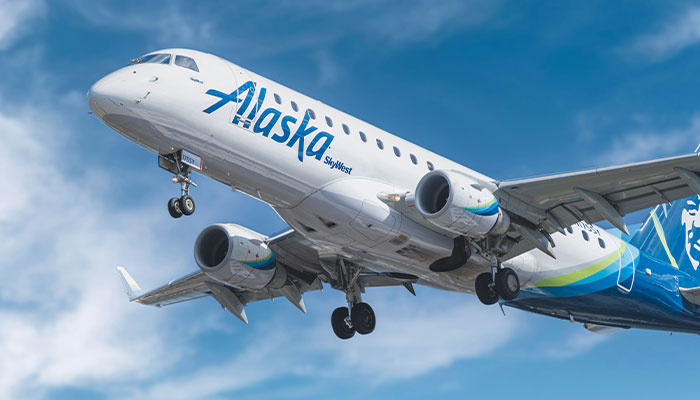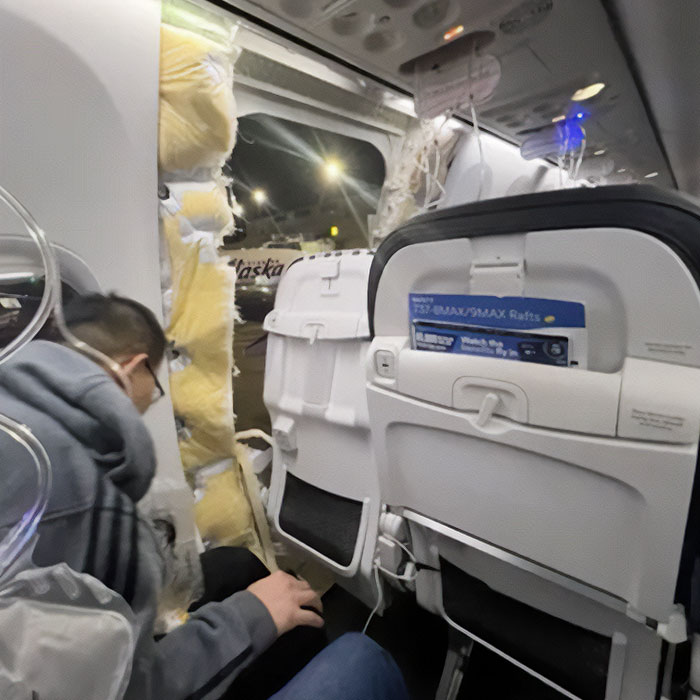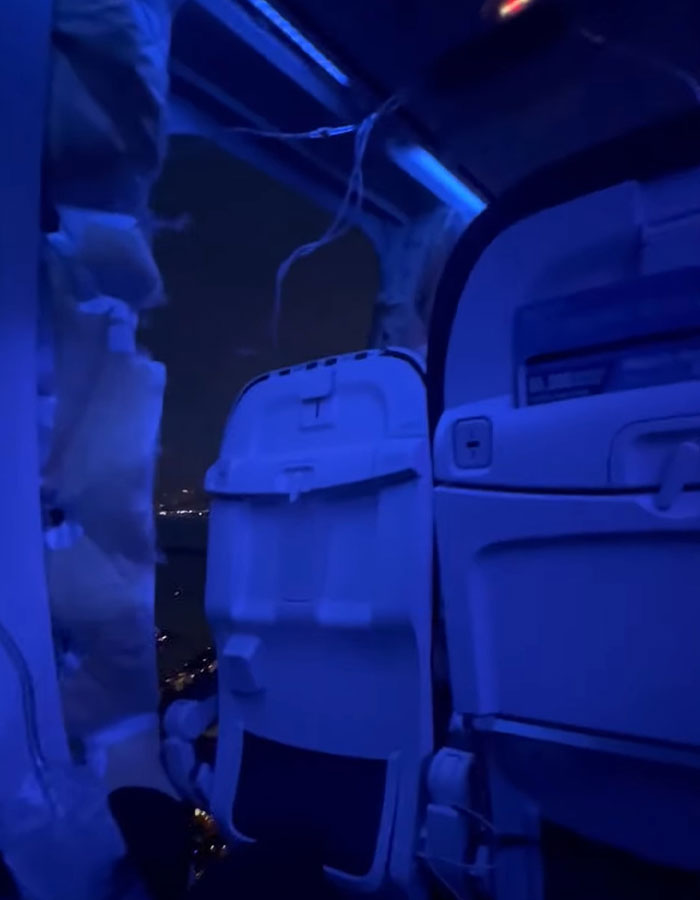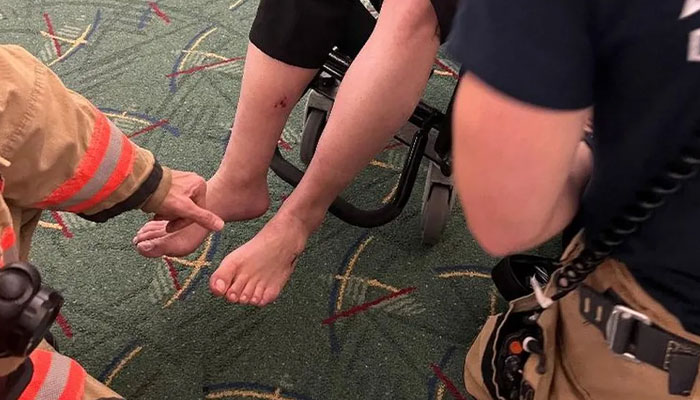Cuong Tran, a man who was aboard the Alaska Airlines plane that lost a door mid-flight, has recently recounted his terrifying experience on the Boeing aircraft.
On January 5, 2024, an Alaska Airlines flight from Portland, Oregon, to Ontario, California, had to do an emergency landing due to an uncontrolled decompression 16,000 ft above Portland.
The incident resulted in oxygen masks dropping from the ceiling of the Boeing 737-9 Max aircraft and one of the plane’s emergency exit doors flying off, leaving passengers close to a gaping hole.
Tran was sitting with his girlfriend one row behind the section that blew out. As a result of the accident, his shoes were vacuumed by the wide hole, and he was left with a leg injury.
Cuong Tran, a man who was aboard the Alaska Airlines plane that lost an emergency door mid-flight, spoke about his terrifying experience

Image credits: Y S/Unsplash
“The captain said we had passed 10,000 feet. Then the hole blew out on us, and I remember my body getting lifted up,” the 40-year-old California native told the BBC.
“Then my whole lower body got sucked down by the howling wind.”
The man added that the decompression took place shortly after take-off and lasted approximately 10 or 20 seconds.
“It was probably the first time in my life I had a feeling of no control over everything. I was in disbelief over the whole situation,” he said, recalling that other passengers were equally as mortified.
“That feeling of no control is pretty terrifying. The suction was so strong and I was hanging on for dear life. Both my shoes ended up getting sucked out. I had my shoe on pretty tight, too.
“My phone, which was in my hand, disappeared.”
The passenger was sitting with his girlfriend one row behind the section that blew out in January

Image credits: Cuong Tran
The plane landed back at Portland International Airport, where passengers were looked after by emergency services. None of the 177 passengers and crew on board were killed.
Sitting close to a wide hole and having no way of telling the time, Tran found it extremely challenging to find the necessary patience to wait for the plane to touch the ground.
“They said it took 30 minutes, but it felt like a lot longer.
“I had no phone so had no idea of the time, so I was just sat there staring into the hole this whole time and hoped it wouldn’t get any more damage.
“That was the scariest moment, the waiting. My body is recovering, but there is a big scar [on] my leg. I don’t know if it [is] going to be gone any time.”
In a preliminary investigation, US regulators found that four critical bolts meant to hold the so-called door plug in place were missing from the aircraft, according to the BBC.
“My whole lower body got sucked down by the howling wind,” Tran described

Image credits: Huy Tran
Tran is among seven passengers who have filed a lawsuit against Boeing, Alaska Airlines, and aerostructure manufacturer Spirit AeroSystems for the traumatizing mid-air scare.
They claim the event left them with physical injuries and “serious emotional distress, fear, and anxiety.”
Attorney Timothy A Loranger said Tran’s “leg was almost sucked out of the airplane if it wasn’t for his seatbelt.”
The plaintiffs are seeking punitive, compensatory, and general damages, although the lawsuit does not specify an amount, as per the British broadcaster.
Following the lawsuit, the Federal Aviation Administration (FAA) ordered all airlines to ground the specific Boeing model, of which approximately 171 exist worldwide.
“It was probably the first time in my life I had a feeling of no control over everything,” he said
@strawberr.vy Girls’ trip turned into emergency landing trip… #alaska #alaskaair ♬ original sound – vy 🍓The US National Transportation Safety Board (NTSB) Chair Jennifer Homendy revealed that the door plug that failed had been opened so rivet repair work could be done in September of last year.
“To date, we still do not know who performed the work to open, reinstall, and close the door plug on the accident aircraft,” Homendy said.
“The absence of those records will complicate the NTSB’s investigation moving forward.”
The repair work reportedly took place at Boeing’s Renton, Washington, facility before the delivery to Alaska Airlines on October 31, 2023.
The incident resulted in oxygen masks dropping from the ceiling of the aircraft and one of the plane’s emergency exit doors flying off
Image credits: Huy Tran
Last Wednesday (March 13), the NTSB informed that it will hold a two-day investigative hearing on the incident at the start of August.
Earlier this month, the FAA said that a six-week audit of the 737 Max production process at Boeing and its supplier Spirit Aerosystems had found “multiple instances where the companies failed to comply with manufacturing quality control requirements.”
Boeing responded to the US regulator by saying it was continuing “to implement immediate changes and develop a comprehensive action plan to strengthen safety and quality and build the confidence of [their] customers and their passengers.”
In recent years, the aviation giant has seen its reputation stained by issues connected to the company’s safety and quality standards in its production process.
Whistleblower John Barnett, who worked at Boeing’s factory in South Carolina from 2010 until his retirement in 2017, claimed the rush to build planes as quickly as possible in order to maximize profits was prioritized over passenger safety.
In 2019, Barnett said that, in some cases, under-pressure workers deliberately installed substandard parts to planes during the production process of the 787 Dreamliner.
“My body is recovering, but there is a big scar [on] my leg. I don’t know if it [is] going to be gone any time,” Tran added

Image credits: BBC
He also uncovered serious problems with oxygen systems, which could mean one in four breathing masks wouldn’t work in an emergency.
However, the biggest Boeing scandal took place five years ago when two of its brand new 737 Max planes were lost in almost identical accidents that cost 346 lives.
The company was accused of concealing information from safety officials about changes to an automated flight control system known as MCAS.
Ultimately, Boeing agreed to pay $2.5bn to settle fraud charges and admitted deception, though it formally pleaded not guilty in court hearings.
“The tragic crashes of Lion Air Flight 610 and Ethiopian Airlines Flight 302 exposed fraudulent and deceptive conduct by employees of one of the world’s leading commercial airplane manufacturers,” said Acting Assistant Attorney General David P. Burns of the US Justice Department’s Criminal Division.
“Boeing’s employees chose the path of profit over candor by concealing material information from the FAA concerning the operation of its 737 Max airplane and engaging in an effort to cover up their deception.”
“I could never fly again after that,” someone wrote



















 English (US) ·
English (US) ·